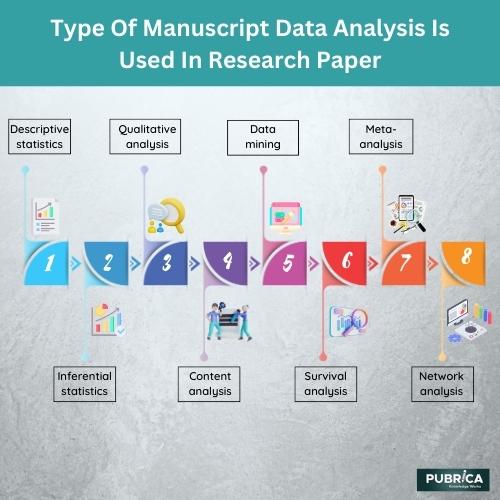What Type Of Manuscript Data Analysis Is Used In the Research Paper?
What Type Of Manuscript Data Analysis Is Used In the Research Paper?
Publishing a research paper is an excellent accomplishment for scientists; they often spend significant time researching the ideal subject, the necessary information, and, most importantly, the appropriate location to publish their hard work. A research paper must be well-written and fulfil all the high criteria to be published. Although there is no quick and simple way to be published, several manuscript writing tactics can help you gain the exposure and visibility you need.
A manuscript is a written, typed, or word-processed document submitted by a researcher to a publisher. Researchers methodically write manuscript editing to share their novel ideas and discoveries with the scientific community and the general public. Overall, the text must be exceptional and accurately reflect your professional approach toward work; it must be thorough, logically arranged, and correct. Scientific publications must utilize a specific language and structure to communicate the results to the scientific community while adhering to ethical guidelines.
Furthermore, the requirements for title page information, abstract structure, reference style, font size, line spacing, margins, layout, and paragraph style must be followed for effective publishing. This is a time-consuming and difficult method, but it is well worth it in the end [1].
The type of manuscript data analysis used in research papers depends on the nature of the research question, the study design, and the data collected.

Here are some common types of manuscript data analysis techniques used in research papers:
- Descriptive statistics: Descriptive statistics summarize and describe the main characteristics of big data, such as measures of central tendency (mean, median, mode) and measures of dispersion (variance, standard deviation).
- Inferential statistics: Inferential statistics are used to draw conclusions and make inferences about a population based on a sample. Techniques such as hypothesis testing, t-tests, analysis of variance (ANOVA), chi-square tests, regression analysis, and correlation analysis are commonly used.
- Qualitative analysis: Qualitative analysis involves analyzing non-numerical data, such as textual data from interviews, focus groups, or observations. Techniques like thematic analysis, content analysis, and grounded theory are used to identify data patterns, themes, and relationships.
- Content analysis: Content analysis is a systematic approach to analyzing textual or visual content. It involves categorizing and quantifying the content based on predefined criteria or emerging themes.
- Data mining: Data mining techniques are used to discover patterns and relationships in large datasets. It involves using algorithms and statistical models to extract knowledge and insights from the data.
- Survival analysis: Survival analysis analyses time-to-event data, such as the time until an event occurs or the time until failure. Techniques like Kaplan-Meier analysis and Cox proportional hazards regression are commonly used in survival analysis.
- Meta-analysis: Meta-analysis is a statistical technique used to combine and analyze data from multiple studies on the same topic. It aims to provide a quantitative summary of the results and increase the statistical power of the analysis.
- Network analysis: Network analysis involves studying the relationships and connections between entities in a network. It can be applied to various fields, including social, biological, and transportation networks.
These are just a few examples of manuscript data analysis techniques used in research papers. The choice of analysis depends on the research question, the study design, and available data. Researchers often use a combination of these techniques to address their research objectives.
Give yourself the Medical edge today
Each order includes
- On-time delivery or your money back
- A fully qualified writer in your subject
- In-depth proofreading by our Quality Control Team
- 100% confidentiality, the work is never re-sold or published
- Standard 7-day amendment period
- A paper written to the standard ordered
- A detailed plagiarism report
- A comprehensive quality report

